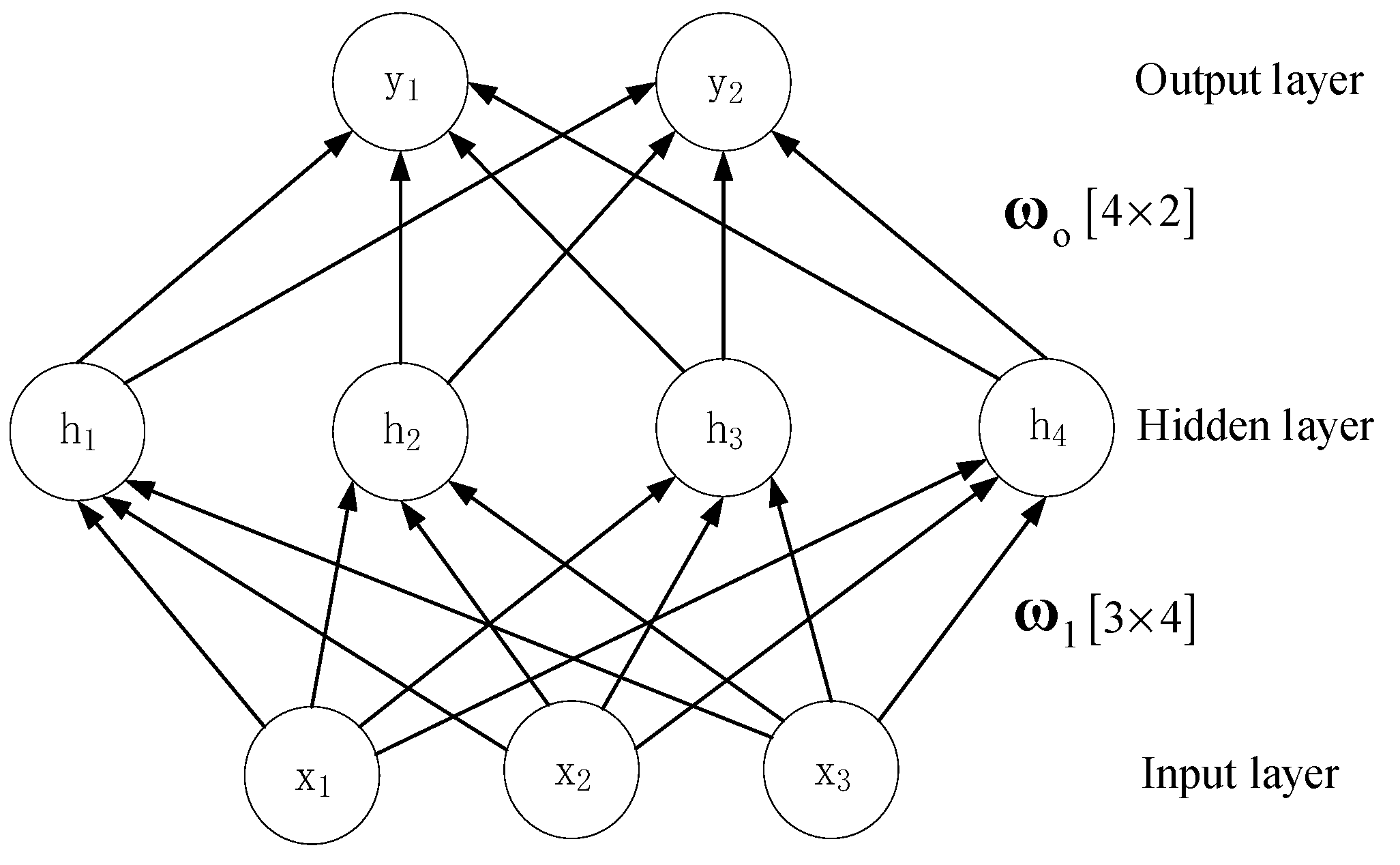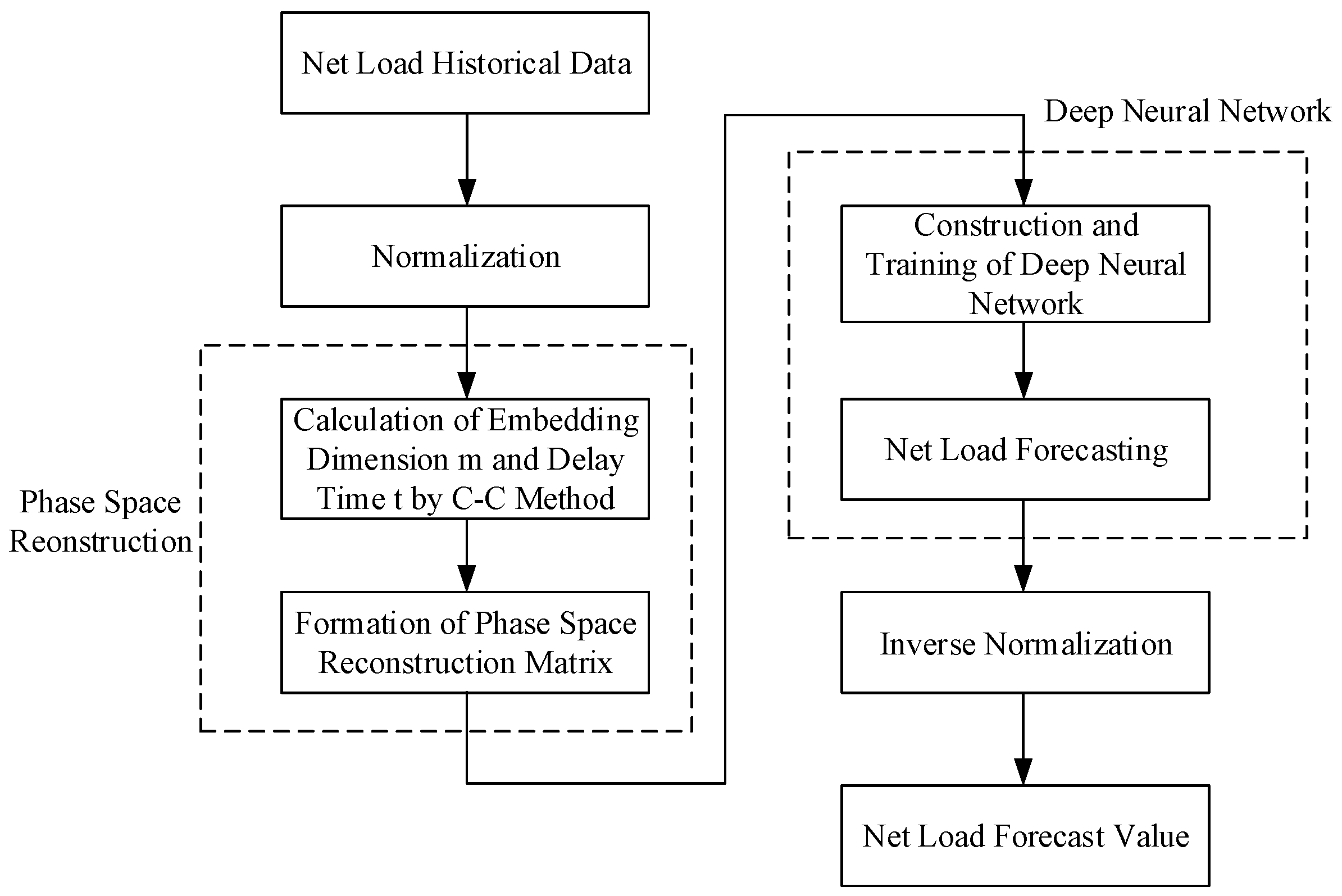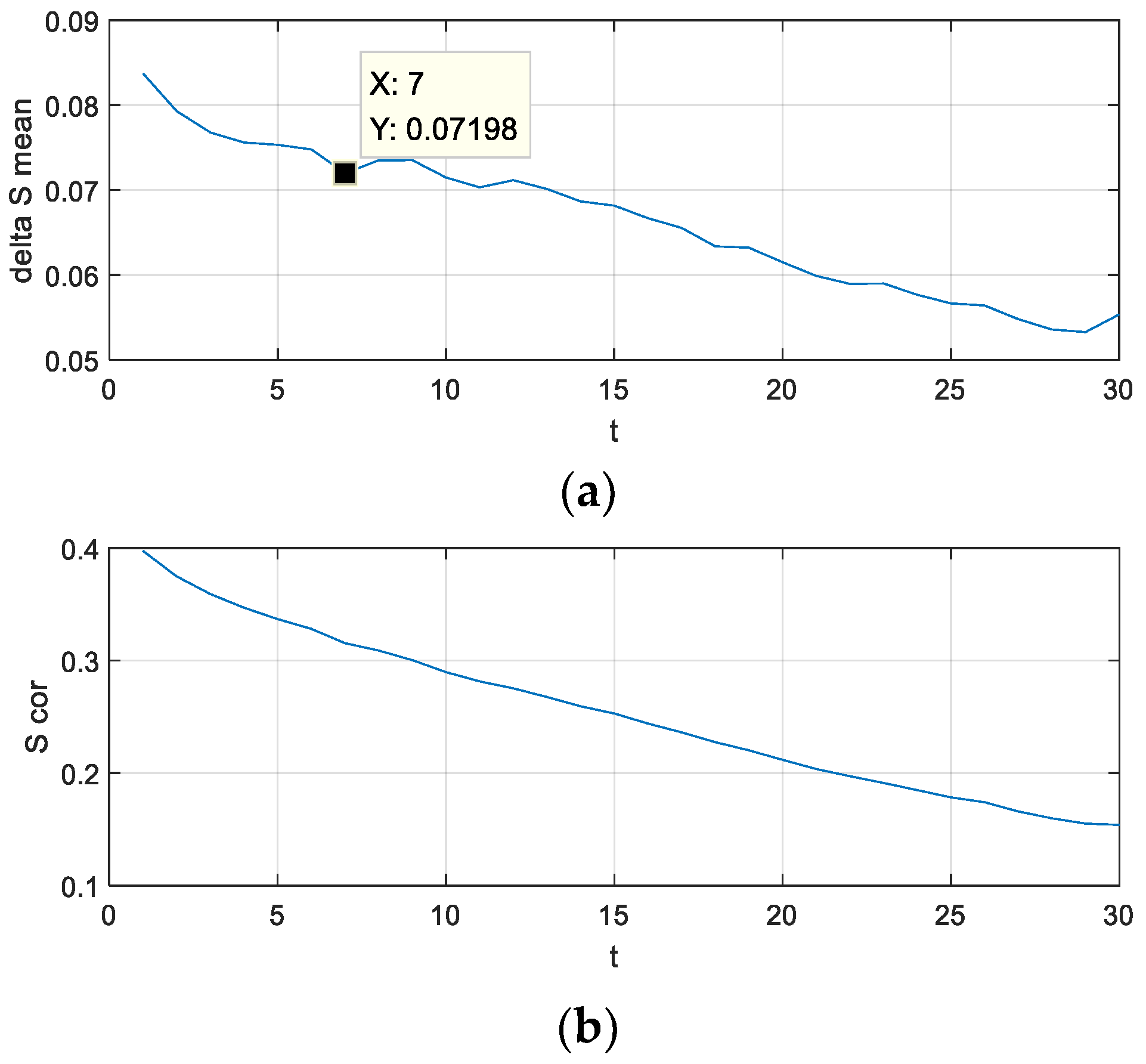An Ultrashort-Term Net Load Forecasting Model Based on Phase Space Reconstruction and Deep Neural Network
Abstract
1. Introduction
- The bus load prediction model is established considering distributed PV power supply. The prediction results are necessary guidance for the power grid dispatching, which is conducive to the improvement of PV consumption.
- The phase space reconstruction is used to process bus load data, and one-dimensional time series data are inversely constructed into the phase space structure of the original system, which can better describe the dynamic characteristics and adapt to the strong fluctuation of the bus load.
- Levenberg-Marquardt back propagation (LMBP) algorithm is used to train DNN, which accelerates the training speed. Compared with the single hidden layer neural network, DNN can fit the historical data better and significantly improve the accuracy of ultrashort-term load forecasting.
2. Fundamental of Phase Space Reconstruction and Deep Neural Network
2.1. Phase Space Reconstruction
2.2. Deep Neural Network
3. Ultrashort-Term Load Forecasting Model Based on Phase Space Reconstruction and Deep Neural Network
3.1. Modelling Steps of Prediction Model
- Step 1: The load time series is linearly normalized to facilitate the training of DNN. The maximum and minimum values of the data are saved for the reverse normalization of the load forecasting value to restore the actual value.
- Step 2: The C-C method is used to process the load time series, and the optimal embedded dimension mopt and optimal delay topt of the time series are obtained.
- Step 3: The load time series are reconstructed according to the embedding dimension m and delay t obtained in Step 2. The phase space matrix of the reconstructed load time series is as follows. In Formula (15), .
- Step 4: The p neural network is constructed, and the phase space matrix of load time series reconstructed in Step 3 is used as the training set to train the DNN. The trained DNN is used to predict the load value immediately after training.
- Step 5: Using the maximum and minimum values stored in Step 1, the load prediction values returned by the DNN are inverse-normalized to obtain the actual load prediction values.
- The model workflow chart is shown in Figure 2.
3.2. Determination of the Structure of Deep Neural Networks
4. Analysis of Prediction Results
4.1. Result of the Phase Space Reconstruction by the C-C Method
4.2. Prediction Results of the Deep Neural Network
5. Conclusions
- A large amount of access to the distributed PV power generation results in the increasing fluctuation of the net load power, which challenges the ultrashort-term load forecasting. Considering this phenomenon and the characteristics of ultrashort-term load forecasting, this paper presents a model of ultrashort-term load forecasting based on the phase space reconstruction and DNN. Based on the phase space reconstruction, the time series is projected into a moving point in the phase space, and the DNN is subsequently used to fit the trajectory to realize the load forecasting.
- The prediction of the actual load data and a comparison experiment with the BP neural network prediction model have verified that the proposed model has higher prediction accuracy even in the case of large distributed PV power fluctuations and different weather conditions. In particular, when there is a large amount of PV power access and high penetration, there is also an ideal predictive performance.
Author Contributions
Funding
Conflicts of Interest
References
- Li, L.L.; Sun, J.; Wang, C.H.; Zhou, Y.T.; Lin, K.P. Enhanced Gaussian process mixture model for short-term electric load forecasting. Inf. Sci. 2019, 477, 386–398. [Google Scholar] [CrossRef]
- Sun, W.; Zhang, C.C. A Hybrid BA-ELM Model Based on Factor Analysis and Similar-Day Approach for Short-Term Load Forecasting. Energies 2018, 11, 1282. [Google Scholar] [CrossRef]
- Barman, M.; Choudhury, N.B.D.; Sutradhar, S. A regional hybrid GOA-SVM model based on similar day approach for short-term load forecasting in Assam, India. Energy 2018, 145, 710–720. [Google Scholar] [CrossRef]
- Zhang, J.L.; Wei, Y.M.; Li, D.Z.; Tan, Z.F.; Zhou, J.H. Short term electricity load forecasting using a hybrid model. Energy 2018, 158, 774–781. [Google Scholar] [CrossRef]
- Li, Y.Y.; Han, D.; Yan, Z. Long-term system load forecasting based on data-driven linear clustering method. J. Mod. Power Syst. Clean Energy 2018, 6, 306–316. [Google Scholar] [CrossRef]
- Bennett, C.J.; Stewart, R.A.; Lu, J.W. Forecasting low voltage distribution network demand profiles using a pattern recognition based expert system. Energy 2014, 67, 200–212. [Google Scholar] [CrossRef]
- Kazemi, S.M.R.; Hoseini, M.M.S.; Abbasian-Naghneh, S.; Rahmati, S.H.A. An evolutionary-based adaptive neuro-fuzzy inference system for intelligent short-term load forecasting. Int. Trans. Oper. Res. 2014, 21, 311–326. [Google Scholar] [CrossRef]
- Ahmad, T.; Chen, H.X. Nonlinear autoregressive and random forest approaches to forecasting electricity load for utility energy management systems. Sustain. Cities Soc. 2019, 45, 460–473. [Google Scholar] [CrossRef]
- Massidda, L.; Marrocu, M. Smart Meter Forecasting from One Minute to One Year Horizons. Energies 2018, 11, 3520. [Google Scholar] [CrossRef]
- Alamaniotis, M.; Ikonomopoulos, A.; Tsoukalas, L.H. Evolutionary Multiobjective Optimization of Kernel-Based Very-Short-Term Load Forecasting. IEEE Trans. Power Syst. 2012, 27, 1477–1484. [Google Scholar] [CrossRef]
- Alamaniotis, M.; Bargiotas, D.; Tsoukalas, L.H. Towards smart energy systems: Application of kernel machine regression for medium term electricity load forecasting. Springerplus 2016, 5, 58. [Google Scholar] [CrossRef] [PubMed]
- Amjady, N. Evolutionary Multiobjective Short-term bus load forecasting of power systems by a new hybrid method. IEEE Trans. Power Syst. 2007, 22, 333–341. [Google Scholar] [CrossRef]
- Hossen, T.; Plathottam, S.J.; Angamuthu, R.K.; Ranganathan, P.; Salehfar, H. Short-Term Load Forecasting Using Deep Neural Networks (DNN). In Proceedings of the 2017 North American Power Symposium (NAPS), Morgantown, WV, USA, 17–19 September 2017. [Google Scholar]
- Chen, Y.; Luh, P.B.; Guan, C.; Zhao, Y.; Michel, L.D.; Coolbeth, M.A.; Friedland, P.B.; Rourke, S.J. Short-Term Load Forecasting: Similar Day-Based Wavelet Neural Networks. IEEE Trans. Power Syst. 2010, 25, 322–330. [Google Scholar] [CrossRef]
- Moon, J.; Kim, Y.; Son, M.; Hwang, E. Hybrid Short-Term Load Forecasting Scheme Using Random Forest and Multilayer Perceptron. Energies 2018, 11, 3283. [Google Scholar] [CrossRef]
- Nazar, M.S.; Fard, A.E.; Heidari, A.; Shafie-Khah, M.; Catalao, J.P.S. Hybrid model using three-stage algorithm for simultaneous load and price forecasting. Electr. Power Syst. Res. 2018, 165, 214–228. [Google Scholar] [CrossRef]
- Zhang, B.; Liu, W.; Li, S.T.; Wang, W.G.; Zou, H.; Dou, Z.H. Short-term load forecasting based on wavelet neural network with adaptive mutation bat optimization algorithm. IEEJ Trans. Electr. Electron. Eng. 2019, 14, 376–382. [Google Scholar] [CrossRef]
- Liang, Y.; Niu, D.X.; Hong, W.C. Short term load forecasting based on feature extraction and improved general regression neural network model. Energy 2019, 166, 653–663. [Google Scholar] [CrossRef]
- Dai, S.Y.; Niu, D.X.; Li, Y. Daily Peak Load Forecasting Based on Complete Ensemble Empirical Mode Decomposition with Adaptive Noise and Support Vector Machine Optimized by Modified Grey Wolf Optimization Algorithm. Energies 2018, 11, 163. [Google Scholar] [CrossRef]
- Heymann, F.; Silva, J.; Miranda, V.; Melo, J.; Soares, F.J.; Padilha-Feltrin, A. Distribution network planning considering technology diffusion dynamics and spatial net-load behavior. Int. J. Electr. Power Energy Syst. 2019, 106, 254–265. [Google Scholar] [CrossRef]
- Elghitani, F.; El-Saadany, E. Smoothing Net Load Demand Variations Using Residential Demand Management. IEEE Trans. Ind. Inform. 2019, 15, 390–398. [Google Scholar] [CrossRef]
- Kuppannagari, S.R.; Kannan, R.; Prasanna, V.K. Optimal Discrete Net-Load Balancing in Smart Grids with High PV Penetration. ACM Trans. Sens. Netw. 2018, 14, 24. [Google Scholar] [CrossRef]
- Zhou, X.; Zi, X.H.; Liang, L.Q.; Fan, Z.B.; Yan, J.W.; Pan, D.M. Forecasting performance comparison of two hybrid machine learning models for cooling load of a large-scale commercial building. J. Build. Eng. 2018, 21, 64–73. [Google Scholar] [CrossRef]
- Kong, W.C.; Dong, Z.Y.; Jia, Y.W.; Hill, D.J.; Xu, Y.; Zhang, Y. Short-Term Residential Load Forecasting Based on LSTM Recurrent Neural Network. IEEE Trans. Smart Grid 2019, 10, 841–851. [Google Scholar] [CrossRef]
- Kim, H.S.; Eykholt, R.; Salas, J.D. Nonlinear dynamics, delay times, and embedding windows. Physica D 1999, 127, 48–60. [Google Scholar] [CrossRef]





| Date | MAPE (%) | RMSE | ||
|---|---|---|---|---|
| C-C DNN | BPNN | C-C DNN | BPNN | |
| 12 May (Sunny) | 8.8838 | 18.3725 | 0.8973 | 1.3327 |
| 13 May (Cloudy) | 9.9978 | 17.6827 | 1.3970 | 1.8242 |
| 14 May (Cloudy) | 15.4156 | 17.6415 | 1.1193 | 1.3648 |
| 15 May (Sunny) | 4.0648 | 4.6388 | 1.0972 | 1.1916 |
© 2019 by the authors. Licensee MDPI, Basel, Switzerland. This article is an open access article distributed under the terms and conditions of the Creative Commons Attribution (CC BY) license (http://creativecommons.org/licenses/by/4.0/).
Share and Cite
Mei, F.; Wu, Q.; Shi, T.; Lu, J.; Pan, Y.; Zheng, J. An Ultrashort-Term Net Load Forecasting Model Based on Phase Space Reconstruction and Deep Neural Network. Appl. Sci. 2019, 9, 1487. https://doi.org/10.3390/app9071487
Mei F, Wu Q, Shi T, Lu J, Pan Y, Zheng J. An Ultrashort-Term Net Load Forecasting Model Based on Phase Space Reconstruction and Deep Neural Network. Applied Sciences. 2019; 9(7):1487. https://doi.org/10.3390/app9071487
Chicago/Turabian StyleMei, Fei, Qingliang Wu, Tian Shi, Jixiang Lu, Yi Pan, and Jianyong Zheng. 2019. "An Ultrashort-Term Net Load Forecasting Model Based on Phase Space Reconstruction and Deep Neural Network" Applied Sciences 9, no. 7: 1487. https://doi.org/10.3390/app9071487
APA StyleMei, F., Wu, Q., Shi, T., Lu, J., Pan, Y., & Zheng, J. (2019). An Ultrashort-Term Net Load Forecasting Model Based on Phase Space Reconstruction and Deep Neural Network. Applied Sciences, 9(7), 1487. https://doi.org/10.3390/app9071487





